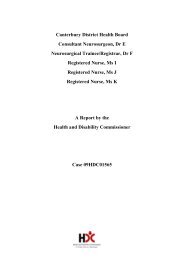Download the pdf version of this decision. - Health and Disability ...
Download the pdf version of this decision. - Health and Disability ...
Download the pdf version of this decision. - Health and Disability ...
You also want an ePaper? Increase the reach of your titles
YUMPU automatically turns print PDFs into web optimized ePapers that Google loves.
<strong>Health</strong> <strong>and</strong> <strong>Disability</strong> Commissioner<br />
Information reviewed<br />
• Relevant medical records from <strong>the</strong> private hospital<br />
• Relevant medical records from <strong>the</strong> public hospital<br />
• Relevant protocols from <strong>the</strong> private hospital<br />
Information ga<strong>the</strong>red during investigation<br />
Adenotonsillectomy<br />
On 18 October 1999, at about 9.30am, nine-year-old Miss C had her adenoids <strong>and</strong> tonsils<br />
removed by ear, nose <strong>and</strong> throat surgeon Dr D, at <strong>the</strong> private hospital. The anaes<strong>the</strong>tist was<br />
Dr E. Dr E <strong>and</strong> Dr D are private specialists <strong>and</strong> are not employed by <strong>the</strong> private hospital.<br />
Insertion <strong>of</strong> IV line<br />
Miss C’s weight on admission to <strong>the</strong> private hospital was 26kg. Prior to Miss C’s<br />
operation, she was given 26mls <strong>of</strong> oral Phenergan as a pre-medication, <strong>and</strong> an intravenous<br />
(“IV”) dextrose saline drip was set up in <strong>the</strong>atre. The anaes<strong>the</strong>tic nurse involved in setting<br />
up <strong>the</strong> drip was Mr F. Mr F had been registered as a comprehensive nurse for four years,<br />
commencing work at <strong>the</strong> private hospital in late May 1999, <strong>and</strong> working full-time in <strong>the</strong><br />
operating <strong>the</strong>atre.<br />
Mr F described <strong>the</strong> process involved in setting up <strong>the</strong> IV drip. He first obtained a bag <strong>of</strong> <strong>the</strong><br />
appropriate IV fluid, which in Miss C’s case was dextrose saline. Each bag <strong>of</strong> dextrose<br />
saline contained 1000mls <strong>of</strong> fluid. He checked <strong>the</strong> expiry date <strong>and</strong> warmed <strong>the</strong> fluid,<br />
assembled <strong>the</strong> IV <strong>the</strong>rapy line in readiness for Miss C’s operation, <strong>and</strong> <strong>the</strong>n assisted Dr E<br />
with Miss C’s intubation. Immediately following Miss C’s intubation Mr F assisted Dr E to<br />
place <strong>and</strong> secure <strong>the</strong> IV line into her arm. The IV was assembled with a continuous flow<br />
set.<br />
A continuous flow set is regulated by means <strong>of</strong> an adjustable clamp. Staff can adjust <strong>the</strong><br />
clamp to ensure <strong>the</strong> set delivers at <strong>the</strong> rate prescribed by <strong>the</strong> anaes<strong>the</strong>tist. IV delivery can<br />
also be controlled by infusion pumps <strong>and</strong> burettes. Burettes (eg, Buretrol) are filled with<br />
<strong>the</strong> amount <strong>of</strong> fluid to be given each hour <strong>and</strong> set at <strong>the</strong> appropriate prescribed drip rate.<br />
Staff fill <strong>the</strong> burette on an hourly basis. This decreases <strong>the</strong> likelihood <strong>of</strong> administering too<br />
much fluid. Infusion pumps are mechanical devices programmed to deliver a pre-set<br />
amount <strong>of</strong> fluid over a certain time period.<br />
Mr F explained that it is normal practice for <strong>the</strong> anaes<strong>the</strong>tic nurse to assemble <strong>the</strong> IV line<br />
with a continuous flow set, unless o<strong>the</strong>rwise ordered by <strong>the</strong> anaes<strong>the</strong>tist or if <strong>the</strong> child is an<br />
infant. This is because sometimes, in <strong>the</strong> <strong>the</strong>atre setting, <strong>the</strong> IV infusion is used as a means<br />
<strong>of</strong> administering fluids or medications at a rapid rate. The anaes<strong>the</strong>tist makes <strong>decision</strong>s<br />
concerning <strong>the</strong> IV delivery rate. This rate can be variable, <strong>and</strong> is related to <strong>the</strong> patient’s<br />
needs while undergoing <strong>the</strong> operation. As <strong>the</strong> anaes<strong>the</strong>tist is present <strong>the</strong>re is <strong>of</strong>ten no<br />
2 18 June 2002<br />
Names have been removed to protect privacy. Identifying letters are assigned in alphabetical order <strong>and</strong><br />
bear no relationship to <strong>the</strong> person’s actual name.
















